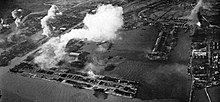Operation transom
| date | May 17-18, 1944 |
|---|---|
| place | Surabaja , Java |
| output |
| Parties to the conflict | |
|---|---|
| Commander | |
| losses | |
|
1 plane |
12 planes, |
The operation transom was an air strike British and American carrier based aircraft on targets in Surabaya on the island of Java in the Japanese occupied the Dutch East Indies in the Pacific theater during World War II .
planning
When she arrived in Ceylon on April 27, 1944 after participating in Operation Cockpit , the USS Saratoga was ordered back to the USA for a general overhaul . Admiral Ernest J. King proposed an attack on Surabaya because the Japanese-occupied island of Java is on the Saratoga route to the United States. To do this he needed the help of the British Eastern Fleet under James Somerville .
The proposed company was practically a replication of the concept first implemented with Operation Cockpit .
Somerville then planned to conduct the Gulf of Exmouth operation in Western Australia and made arrangements to refuel the Eastern Fleet ships there.
The ships were divided into two task force units:
- TF 65, consisting of the battleships Queen Elizabeth , Valiant and the French Richelieu , the cruisers Newcastle , Nigeria and Tromp from the Netherlands , as well as the destroyers Rotherham , Racehorse , Penn , Napier , Nepal , the Australian Quiberon and Quickmatch and the Dutch Van Galen under the command of Admiral Somerville ran at 17:00 from May 6 Trincomalee from.
- TF 66, under the command of Vice Admiral Power, with the battlecruisers Renown (which switched to TF.65 on May 7th), the aircraft carriers Illustrious and the American Saratoga , the cruisers Ceylon , and the New Zealand Gambia and the destroyers Quilliam , Quadrant , Queenborough and the American Cummings , Dunlap , Fanning ran the same day. From Colombo.
The combined fleet ran a far south course, which kept them nearly 1,000 km from the Nicobar Islands , Sumatra and Java so that Japanese reconnaissance planes could not detect them. The Gulf of Exmouth was reached on May 15th. Refueling was carried out by the TF 67, which was on site with six fleet oilers and one water tanker . The heavy cruisers London and Suffolk served as escorts . The two cruisers of the TF 67 joined the TF 66 on May 14th.
Admiral Somerville expected a significantly stronger defensive reaction from the Japanese for this operation than during Operation Cockpit. Therefore he set a target distance of 340 km for the position of the launch of the carrier aircraft. Since this was outside the tactical radius of the Fairey Barracudas , the Illustrious was instead equipped with Grumman Avengers of the 832nd and 845th squadrons .
attack
On the afternoon of May 15, the fleet left the Gulf of Exmouth. Somerville let the ships sail at 20 knots during the night and only 15 knots during the day so that smoke emissions were reduced to a possible minimum in order to avoid detection by Japanese reconnaissance planes.
Even before reaching the attack position, the Renown , London and Suffolk switched to the TF 66 in order to give it more air defense support. Tactical command for the attack was given to Vice Admiral Power on the Illustrious . This was a decision learned from previous operations where aircraft carriers were left uncovered while the rest of the fleet continued on its original course independently of them.
Early in the morning at 4:30 am on May 17, Java started south of the Illustrious and the Saratoga 45 Avenger- and Dauntless - Dive Bomber . The escort took 40 Hellcat - and Corsair -Jäger. The planes split into two attack groups. Group A flew an attack against the oil refineries in Wonokromo district and Group B against the port of Surabaya. There mainly against military targets and a dry dock .
Without Japanese resistance in the air and little anti-aircraft fire, twelve aircraft were destroyed on the ground. A loss of my own had to be accepted.
However, the damage caused to the port facilities and ships was minimal. The Shinrei Maru transporter was sunk and the P-36 / Fiji patrol boat was so badly damaged that it had to be abandoned. The auxiliary submarine hunters Cha 107 and Cha 108 , as well as the freighters Choka Maru , Tencho Maru and the tanker Yosei Maru were also damaged. However, the wonokromo oil refinery was hit so badly that it subsequently burned out.
Photographs of the damage done on the Queen Elizabeth and Renown showed that many targets were essentially undamaged. But it was too late for a second coordinated attack. However, the following night seven land-based Consolidated B-24 Liberator heavy bombers of the 380th Bombardment Group were able to carry out a follow-up attack on the port of Surabaja from their base at Corunna Downs Airfield in Western Australia .
On May 18th the Saratoga and the 3 American destroyers were released. The rest of the Allied forces began their march back to Ceylon, where they entered on May 27th.
Individual evidence
- ↑ a b c Christopher Chant: The Encyclopedia of Codenames of World War II . Routledge Kegan & Paul Publishing House, 1987, ISBN 978-0-7102-0718-0 (English, codenames.info [accessed July 3, 2020]).
- ↑ a b c d Jürgen Rohwer: Chronicle of the Naval War 1939-1945. Württemberg State Library Stuttgart 2007 to 2020, accessed on July 3, 2020 .
- ↑ a b c d e f David Hobbs: The British Pacific Fleet: The Royal Navy's Most Powerful Strike Force . Naval Institute Press, 2011, ISBN 978-1-59114-044-3 (English, google.de [accessed July 4, 2020]).
- ↑ Edvyn Gray: Operation Pacific. The Royal Navy's War Against Japan, 1941-1945 . Naval Institute Press, 1991, ISBN 978-1-55750-650-4 (English, google.de [accessed July 4, 2020]).


